
The methodical approach that Lexus and Toyota have nearly perfected in the progression of their vehicles has paid off well for the recent introduction of several all-new models. When it comes to a midsized three-row crossover, Lexus finally gets a proper one in the all-new TX, which comes in a variety of trim levels and powertrains. The Lexus TX 500h F Sport Performance that I got to play with for a week has set off on a surprising path to become a benchmark for the midsize three-row luxury crossover, which is a good thing for something that’s arrived in the segment a little late.
The simplistic approach and conservative design for the new Lexus TX are well perceived to avoid turning people away, which is also a good thing. During my time with the TX in the 500h F Sport Performance version, which is supposedly a sportier flavor for the crossover, there’s a lot to appreciate, leaving me to dig a little deep to find faults. From its unique take on a new front grille that doesn’t offend to its large 22-inch wheels and upright stature, the Lexus TX 500h F Sport Performance is a pleasing vehicle that will do well to attract brand loyalists and those far outside of the Lexus spectrum.
Also, don’t forget that you can get discounted new car pricing with a free quote through qualified local dealer partners.

In the tradition of Lexus vehicles, the TX 500h F Sport Performance exudes an overall soft quality in how it rides, drives, and behaves despite wearing a multitude of F Sport badges. As a hybrid, the TX 500h F Sport Performance utilizes its unique drivetrain to be a respected performer as well as a vehicle that attempts to return decent fuel economy.

The hybrid powertrain is comprised of a 2.4-liter turbocharged 4-cylinder engine, an electric motor out back to power the rear wheels for an all-wheel-drive setup, and a 6-speed automatic transmission. Total power output comes to 366 horsepower and 406 lb-ft of torque. Working in harmony that is expected out of a Lexus, the hybrid system is one of the most seamless, yet that just works as it is supposed to without second thought.
Driving the TX 500h F Sport Performance feels almost like any other Lexus SUV but with a newfound level of refinement out of a hybrid setup that touts a 4-cylinder engine. There’s not much buzzing or unwanted NVH out of the powertrain as the TX just goes when you demand without any hiccups or delays. The hybrid control works in a marvelous fashion, keeping the 1.4-kWh nickel-metal hydride battery pack charged with a decent reserve to utilize when needed. The braking feel is mostly natural but suffers from some inconsistency in switching from regen to feed power to the battery and using the beefy friction brakes, which feature 6-piston calipers up front.
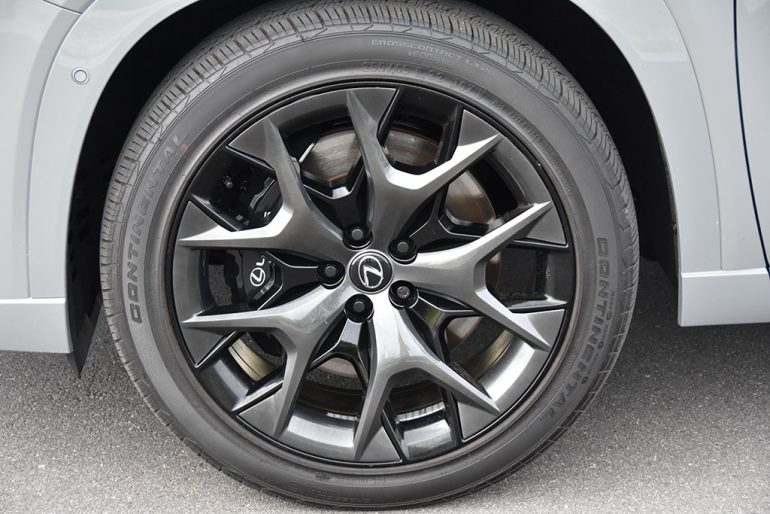
The acceleration is strong in the TX 500h F Sport Performance with plenty of passing power. Zero to 60 mph ticks off in just 5.7 seconds, which is pretty good for a vehicle that tips the scale to 5,119 pounds. The only downfall that I find in the way the TX 500h F Sport Performance handles and rides is its adaptive suspension system, which seems unmatched for its front end versus the rear end. The front feels similar to the RX 500h F Sport Performance with a bit too much lofting around, even in the Sport suspension setting that can be brought up in the Sport drive mode or Custom drive mode by customizing a few individual drive settings characteristics (steering, suspension, powertrain). Otherwise, the ride quality is good, and surprisingly, it is more on the side of being soft and cushy than you expect in a Lexus SUV, even if it is an F Sport trim.
There are many characteristics that carry over from the Lexus RX 500h F Sport Performance, which I welcome because that’s one of my favorite modern Lexus vehicles. There’s even use of the same Dynamic Rear Steering (DRS) system that’s subtle in its approach and doesn’t ever overstep so much that you must correct your steering inputs as you do in many other luxury vehicles with aggressive rear steering setups. The rear steering is welcomed as it virtually shortens the rather long 116.1-inch wheelbase, making for an exceptionally short turning radius and ease of maneuverability in parking lots. The Lexus TX 500h F Sport Performance can tow up to 5,000 pounds.
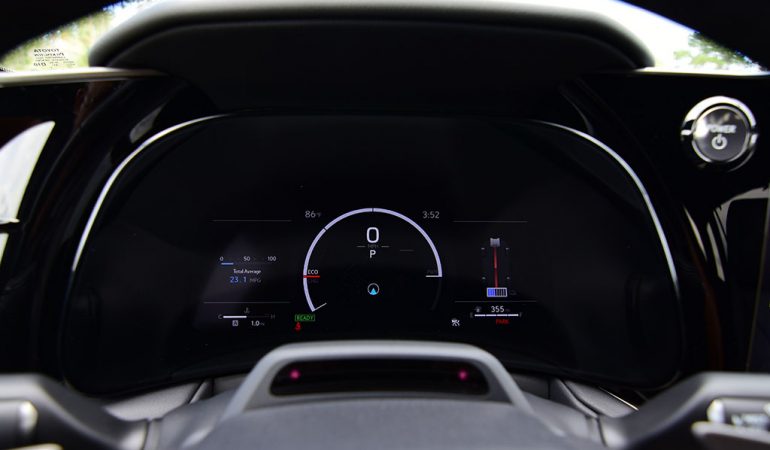
Being a hybrid setup, the Lexus TX 500h F Sport Performance does well in conserving fuel but isn’t afraid of drinking slightly more at times to give you an extra bit of oomph. Unfortunately, as I found in the real world, the fuel consumption falls a little short of the EPA estimates of 27 mpg combined/city and 28 mpg highway, where I averaged about 26.5 mpg with mixed highway and city driving. There’s still the ability to utilize the analog power meter in the digital gauge cluster to monitor your driving aggressiveness and make a mental choice of staying in the ECO range. Doing such will often yield slightly better consumption numbers than the EPA estimates because Toyota and Lexus have some of the best hybrid setups around, and there is a power meter that shows where the engine will fire up versus constant use of battery power.
The fuel tank is on the smaller side at 17.8 gallons because the TX 500h F Sport Performance is still a hybrid with decent fuel consumption, giving you a highway range of around 498 miles.
Sharing its platform with the Toyota Grand Highlander, the Lexus TX takes just about every aspect and makes it a bit plusher and more luxurious. The interior area of the TX, while similar in size to the three-row Grand Highlander, turns its space into a luxurious experience by offering additional soft-touch surfaces and the uniqueness of the heated and ventilated F Sport front seats in my sporty TX 500h F Sport Performance Luxury test vehicle. While the seats are a sportier flavor, they remain exceptionally comfortable for people of most sizes, even though they have additional bolstering over other set options. The only thing I wish Lexus would offer for the front seats is a massage function, which many competitors offer.
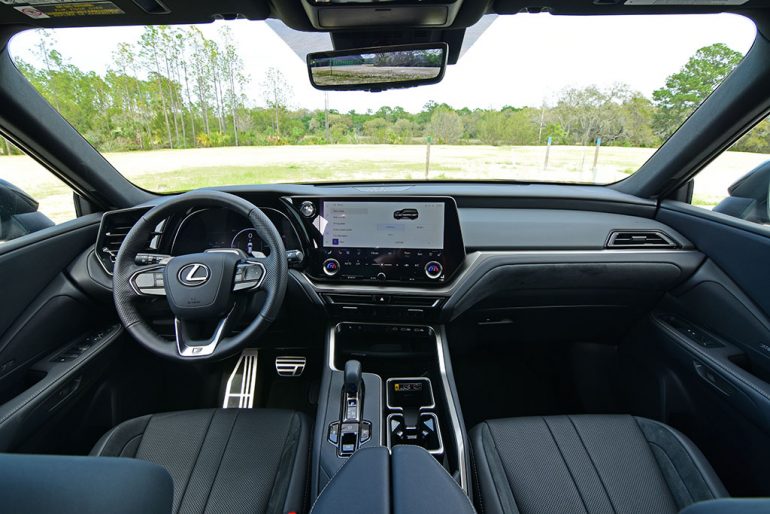
The 6-passenger setup in the F Sport may be somewhat of a compromise, but it proves to be accommodating for its second-row captain’s chairs, which have heating and ventilation. There’s a simplistic manual adjustment of the second-row seats for forward and rearward movement and reclining. The quick action for folding forward is accessed by a button to gain easy entry into the third row, leaving room to leave some smaller child car seats in place. The third row is a two-seat setup as the TX is only a six or seven-passenger vehicle. Room in the third row is good but can quickly cut into legroom if the second-row seats are adjusted far back in their tracks.
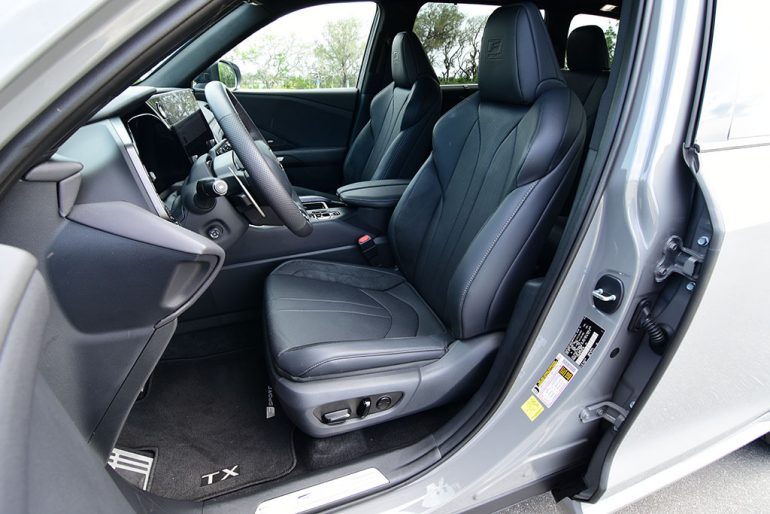
The latest infotainment system, which uses a now-familiar 14-inch touchscreen, remains simple in its operation. A recent update adds some welcomed functionality where when using Apple CarPlay or Android Auto integration, either wireless or USB connected, the core infotainment function icons can be displayed on the left, giving you quicker access to other features and functions. Such a simple change in the update goes a long way toward making better use of all the screen real estate.
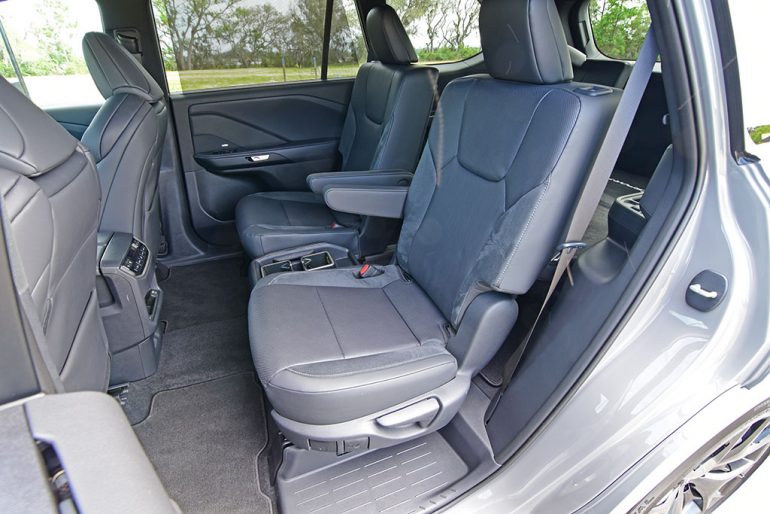
Lexus has a clever use of physical turn knobs for the climate control temperature adjustments and displays the other climate functions at the bottom of the touch screen, which can open up to a full set of functions you can for quick access features. The digital gauge cluster is somewhat cumbersome for customizing through a set of three preset screen displays.
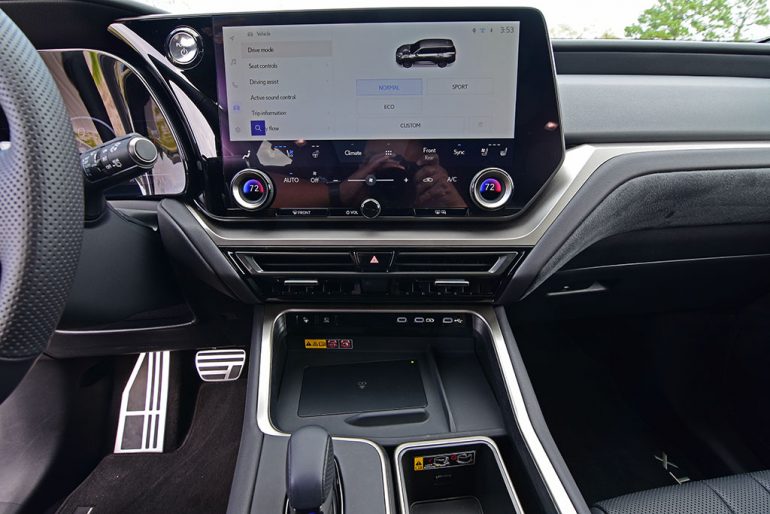
The power-tilt and telescoping heated steering wheel’s function buttons have a unique touch capacitive response that displays where your fingers are placed – all displayed through the large color head-up display. Often enough, the touch function displayed on the HUD can be annoying with unintended touches on the steering wheel, but those functions cannot be activated unless you fully press the buttons or toggle pads.
Overall, the interior space is luxurious but not at the upper end of luxury as it is void of unique materials like wood or metals. The TX excels in its generous cargo space, offering just over 20 cubic feet behind the third row of seats and as much as 97 cubic feet when you power fold the third row and manually fold the second row seats.
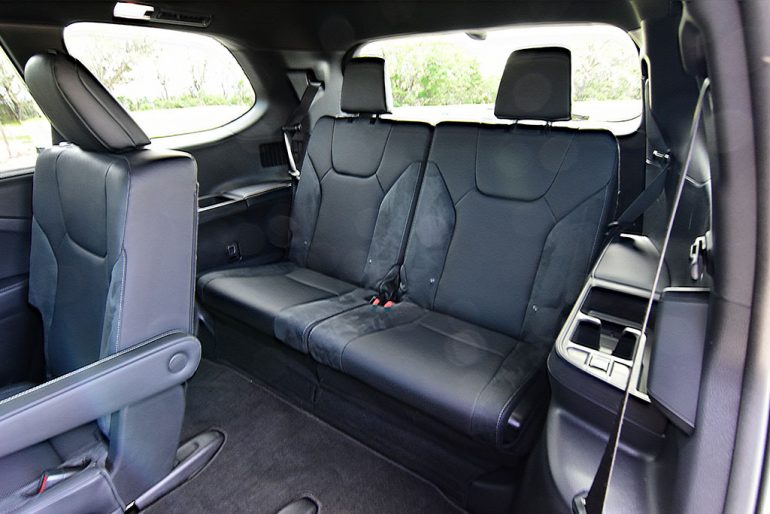
As expected, Lexus offers a full array of active safety features for all trim levels. The only highlights that are reserved for the top trim levels include the surround-view camera system that wonderfully maps what is under the vehicle, front cross-traffic warning, traffic jam assist, and an automated parking system. Otherwise, you get the typical lane departure alert with steering assist, lane centering, lane tracing assist, blind spot monitors, forward collision warning/emergency braking, rear cross-traffic alert/emergency braking, and adaptive cruise control.
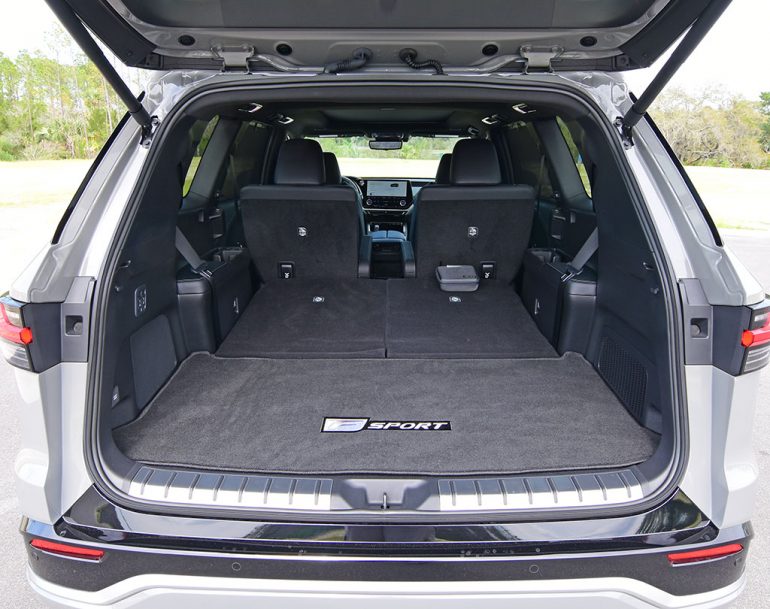
Lexus keeps things reasonable for its all-new TX, which starts at $55,050 for the base TX 350 before any fees or options. Having three powertrain options and two seating configurations offers something for nearly everyone shopping in such a segment, which can easily rise to nearly $70K. My loaded with several small add-ons Lexus TX 500h F Sport Performance Luxury test vehicle comes to a price of $78,254, which includes a destination charge of $1,350.